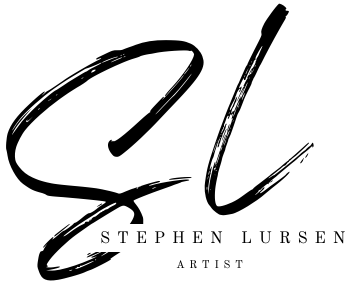Welcome to my blog here at Stephenlursen.com! I'm glad you came! In this post I explain 7 types of acrylic paint. I believe that we are better artists when we get to use the right material for the job! I hope this educational video helps you in your search to better understand why there are so many options at the art supply store and why you would use each type of paint.
The acrylic paint types I talk about in this video are:
- Acrylic medium: Pastes such as molding paste or light molding paste - These pastes are used to thicken your liquid paint to the point that you can sculpt or press it through a detailed stencil. When using a stencil, the paint/paste mixture will hold its 3D shape with clearly defined edges. Without using a stencil this paint/paste mixture is highly sculptural, and when applied with a palette knife, holds its peaks like firm meringue. This 3D quality is nice because it adds surface texture that can not be imitated by even the highest quality mass produced prints. Pastes make specific techniques possible where a fluid paint would bleed. It is important to note that pastes have a matte finish. Light molding paste is rough to the touch after drying. This means it looks very different than gel mediums which dry smooth/slick and matte or glossy depending on the product used.
- Structure paint: This paint has additional additives that make it hold peaks and form without needing to add a paste or gel to it. As a result of not using a paste, the finished dry peaks from this paint are smooth to the touch and glossy or matte based on the specific paint chosen. Perfect for painting with thick globs with a brush or pallet knife. This paint is typically opaque and excellent for covering. It is therefor bad at luminosity and transparency.
- Heavy Body Paint: Thick and creamy right out of the tube. Often Opaque unless thinned. This paint is versatile but requires being worked with on the pallet to become more fluid for painting with a brush. This paint is similar on consistency to oil paint but lacks the shine once dried because it doesn't actually have oil in it. Great for pallet knife right out of the tube but has limited peak height without adding other mediums to increase sculpt-ability.
- Acrylic latex house paint: Great value! Custom colors can be made in hardware stores. Make sure you buy No VOC paint to keep from breathing harmful odors. This paint is slightly sticky, translucent, and has a slow drip speed. If you paint on a vertical surface like an easel and lay a thick layer down, many minutes will pass before you realize that the paint is flowing down in slow drips. Best used in thinner layers. This paint does really well if you paint on a flat surface laid on the floor or table. This way you can pour the paint into thick brightly colored blobs which self level but won't drip. Drying time is directly proportionate to the amount of paint applied. More paint takes more time to dry. Also, the consistency of this paint is perfect for throwing paint and splattering like Jackson Pollack's paintings!
- Fluid Acrylics: My favorite to work with! Readily available to use right out of the container without having to be worked on a pallet. Wide range of opacity from transparent to opaque. Good coverage and as long as you don't add water or a medium to it, it will stay where you paint it. If you want it to run, this you can spray it with water.
- Liquid acrylic mediums: Numerous options that increase fluidity, transparency, luminosity, and interactivity of paint. Some slow the drying time to allow for more fine tuning while others quicken drying time to allow multiple unique layers to be added without mixing. These are greatly used to decrease control and make room for abstract organic happening within the paint on the surface. As you increase fluidity you give up control but most believe that allows for more naturally occurring beauty.
- Acrylic artist ink: Super thin ink, like india ink, but instead of having a water or shellac base, it is made with acrylic polymer and is therefor compatible within the process of an acrylic painting - without any side effects.
I hope you learned something new and useful for your future painting endeavors! If you would like any more in depth instructional workshops, please visit https://stephenlursen.com/collections/online-workshops-educational-videos
To encourage you to take the leap of faith and invest in your own creativity, I'm giving you a 25% off coupon code that you can use on Online Workshops right here on stephenlursen.com. Coupon Code: QG2WZSALS3H1 (coupon good for any workshop. expires on September 1st, 2016)
Happy Painting!
Stephen
